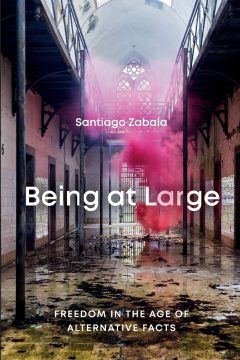Holly Case at the Poetry Foundation:
 “Unlike Lenin, Hitler came to power in a free election, which makes Auschwitz also the result of free elections.” The East German dramatist and poet Heiner Müller wrote these words in late November of 1989, on the eve of the first free elections on the territory of the German Democratic Republic (socialist East Germany) since 1932, when the Nazis came to power. Never one for feel-good moments, Müller’s thinking was deeply out of sync with the general euphoria that followed the fall of the Berlin Wall. While giving a speech on Berlin’s Alexanderplatz on November 4, 1989, he didn’t echo the sweeping optimism of the other speakers but read a statement calling for independent unions; many in the crowd booed him. In his autobiography, Müller admitted that the fall of the GDR had not been easy for him: “Suddenly there was no adversary…whoever no longer has an enemy will meet him in the mirror.”
“Unlike Lenin, Hitler came to power in a free election, which makes Auschwitz also the result of free elections.” The East German dramatist and poet Heiner Müller wrote these words in late November of 1989, on the eve of the first free elections on the territory of the German Democratic Republic (socialist East Germany) since 1932, when the Nazis came to power. Never one for feel-good moments, Müller’s thinking was deeply out of sync with the general euphoria that followed the fall of the Berlin Wall. While giving a speech on Berlin’s Alexanderplatz on November 4, 1989, he didn’t echo the sweeping optimism of the other speakers but read a statement calling for independent unions; many in the crowd booed him. In his autobiography, Müller admitted that the fall of the GDR had not been easy for him: “Suddenly there was no adversary…whoever no longer has an enemy will meet him in the mirror.”
That line proved prophetic. As he was dying of throat cancer in 1995, just a few years after assuming the directorship of Bertolt Brecht’s famous Berliner Ensemble theater, he expressed admiration for his fatal tumor.
More here.

 This point goes to the heart of Zabala’s book, as well as to the mistaken concerns about the hermeneutic tradition he defends. To say, with Zabala, that “there is no ‘neutral observation language’ that can erase human differences,” and that “these differences are not the source of our problems but rather the only possible route to their provisional solution,” is not to embrace or give succor to those making power grabs using bald assertions of “alternative facts,” but the very opposite. It is to say that “facts, information, and data by themselves do nothing. ‘Facts remain robust,’ as [philosopher of science Bruno] Latour says, ‘only when they are supported by a common culture, by institutions that can be trusted, by a more or less decent public life, by more or less reliable media.’” Let’s be quick to douse the realist canard that is sure to arise at this point — that relativist arguments are self-negating since, if all statements of fact are subject to cultural, historical, and institutional contexts, then so is this one — by stating the obvious: of course Zabala’s (and my) positions are subject to the same frame-dependency as anyone else’s, but this is no more self-refuting or paradoxical than to say that all truth statements are made in a natural language that not everyone understands, including this one.
This point goes to the heart of Zabala’s book, as well as to the mistaken concerns about the hermeneutic tradition he defends. To say, with Zabala, that “there is no ‘neutral observation language’ that can erase human differences,” and that “these differences are not the source of our problems but rather the only possible route to their provisional solution,” is not to embrace or give succor to those making power grabs using bald assertions of “alternative facts,” but the very opposite. It is to say that “facts, information, and data by themselves do nothing. ‘Facts remain robust,’ as [philosopher of science Bruno] Latour says, ‘only when they are supported by a common culture, by institutions that can be trusted, by a more or less decent public life, by more or less reliable media.’” Let’s be quick to douse the realist canard that is sure to arise at this point — that relativist arguments are self-negating since, if all statements of fact are subject to cultural, historical, and institutional contexts, then so is this one — by stating the obvious: of course Zabala’s (and my) positions are subject to the same frame-dependency as anyone else’s, but this is no more self-refuting or paradoxical than to say that all truth statements are made in a natural language that not everyone understands, including this one. In its different versions, the tale has several recurring elements, though not all of them are present in every case. The chief one is the jealousy that rages in a beautiful mother (or stepmother, or mother-in-law) for her even more beautiful daughter. Then there is the mirror (or sometimes the sun or the moon and, in one version, a trout in a deep well) that reflects back to the mother the truth about her own beauty being surpassed. Someone is sent to kill the girl in the forest, sometimes a huntsman but occasionally an old woman or a witch; beguiled by the child’s beauty, they set her free, returning to the mother with a bloodstained shirt or an animal’s entrails. Lost in the forest, the child often comes upon a house in which to shelter. It might be lived in by untidy dwarfs (this gave Disney an opportunity to make Snow White into a perfect 1930s housewife), but often its inhabitants are immaculately tidy dwarfs (as in the Grimms’ version), and occasionally they are gangs of robbers or even brothers who look upon Snow White as a sister to be protected. Sometimes there are seven of them in the house, sometimes twelve.
In its different versions, the tale has several recurring elements, though not all of them are present in every case. The chief one is the jealousy that rages in a beautiful mother (or stepmother, or mother-in-law) for her even more beautiful daughter. Then there is the mirror (or sometimes the sun or the moon and, in one version, a trout in a deep well) that reflects back to the mother the truth about her own beauty being surpassed. Someone is sent to kill the girl in the forest, sometimes a huntsman but occasionally an old woman or a witch; beguiled by the child’s beauty, they set her free, returning to the mother with a bloodstained shirt or an animal’s entrails. Lost in the forest, the child often comes upon a house in which to shelter. It might be lived in by untidy dwarfs (this gave Disney an opportunity to make Snow White into a perfect 1930s housewife), but often its inhabitants are immaculately tidy dwarfs (as in the Grimms’ version), and occasionally they are gangs of robbers or even brothers who look upon Snow White as a sister to be protected. Sometimes there are seven of them in the house, sometimes twelve. Ms. Hashmi, who preferred to identify herself professionally by only her first name, became internationally known for woodcuts and intaglio prints, many combining semiabstract images of houses and cities she had lived in accompanied by inscriptions written in Urdu, a language spoken primarily by Muslim South Asians. (It is the official national language of Pakistan.) In South Asia itself, she is particularly revered as a representative of a now-vanishing generation of artists who were alive during the 1947 partition of the subcontinent along ethnic and religious lines, a catastrophic event that, she felt, cut her loose from her roots and haunted her life and work. Zarina Rashid was born on July 16, 1937, the youngest of five children, in the small Indian town of Aligarh, where her father, Sheikh Abdur Rashid, taught at Aligarh Muslim University. Her mother, Fahmida Begum, was a homemaker. In her 2018 memoir, “Directions to My House,” Ms. Hashmi described growing up in what she called a traditional Muslim home. In hot months she and her older sister Rani would sleep outdoors “under the stars and plot our journeys in life.” The floor plan of her childhood house, whose walls enclosed a fragrant garden, became a recurrent presence in her art. That life abruptly ended with the partition of India and the violence between Muslims and Hindus. For safety, her father sent the family to Karachi in the newly formed Pakistan. The experience of fleeing to a refugee camp and seeing bodies left in the road stayed with Ms. Hashmi. “These memories formed how I think about a lot of things: fear, separation, migration, the people you know, or think you know,” she wrote in her memoir.
Ms. Hashmi, who preferred to identify herself professionally by only her first name, became internationally known for woodcuts and intaglio prints, many combining semiabstract images of houses and cities she had lived in accompanied by inscriptions written in Urdu, a language spoken primarily by Muslim South Asians. (It is the official national language of Pakistan.) In South Asia itself, she is particularly revered as a representative of a now-vanishing generation of artists who were alive during the 1947 partition of the subcontinent along ethnic and religious lines, a catastrophic event that, she felt, cut her loose from her roots and haunted her life and work. Zarina Rashid was born on July 16, 1937, the youngest of five children, in the small Indian town of Aligarh, where her father, Sheikh Abdur Rashid, taught at Aligarh Muslim University. Her mother, Fahmida Begum, was a homemaker. In her 2018 memoir, “Directions to My House,” Ms. Hashmi described growing up in what she called a traditional Muslim home. In hot months she and her older sister Rani would sleep outdoors “under the stars and plot our journeys in life.” The floor plan of her childhood house, whose walls enclosed a fragrant garden, became a recurrent presence in her art. That life abruptly ended with the partition of India and the violence between Muslims and Hindus. For safety, her father sent the family to Karachi in the newly formed Pakistan. The experience of fleeing to a refugee camp and seeing bodies left in the road stayed with Ms. Hashmi. “These memories formed how I think about a lot of things: fear, separation, migration, the people you know, or think you know,” she wrote in her memoir. In 1912, German veterinarians puzzled over the case of a feverish cat with an enormously swollen belly. That is now thought to be the first reported example of the debilitating power of a coronavirus. Veterinarians didn’t know it at the time, but coronaviruses were also giving chickens bronchitis, and pigs an intestinal disease that killed almost every piglet under two weeks old. The link between these pathogens remained hidden until the 1960s, when researchers in the United Kingdom and the United States isolated two viruses with crown-like structures causing common colds in humans. Scientists soon noticed that the viruses identified in sick animals had the same bristly structure, studded with spiky protein protrusions. Under electron microscopes, these viruses resembled the solar corona, which led researchers in 1968 to coin the term coronaviruses for the entire group. It was a family of dynamic killers: dog coronaviruses could harm cats, the cat coronavirus could ravage pig intestines. Researchers thought that coronaviruses caused only mild symptoms in humans, until the outbreak of severe acute respiratory syndrome (SARS) in 2003 revealed how easily these versatile viruses could kill people.
In 1912, German veterinarians puzzled over the case of a feverish cat with an enormously swollen belly. That is now thought to be the first reported example of the debilitating power of a coronavirus. Veterinarians didn’t know it at the time, but coronaviruses were also giving chickens bronchitis, and pigs an intestinal disease that killed almost every piglet under two weeks old. The link between these pathogens remained hidden until the 1960s, when researchers in the United Kingdom and the United States isolated two viruses with crown-like structures causing common colds in humans. Scientists soon noticed that the viruses identified in sick animals had the same bristly structure, studded with spiky protein protrusions. Under electron microscopes, these viruses resembled the solar corona, which led researchers in 1968 to coin the term coronaviruses for the entire group. It was a family of dynamic killers: dog coronaviruses could harm cats, the cat coronavirus could ravage pig intestines. Researchers thought that coronaviruses caused only mild symptoms in humans, until the outbreak of severe acute respiratory syndrome (SARS) in 2003 revealed how easily these versatile viruses could kill people. Unless you have studied philosophy, maths or economics, it is unlikely you have heard of Frank Ramsey. And if you have, it is probably as a minor character in stories about his celebrated Cambridge philosophical contemporaries Bertrand Russell and Ludwig Wittgenstein.
Unless you have studied philosophy, maths or economics, it is unlikely you have heard of Frank Ramsey. And if you have, it is probably as a minor character in stories about his celebrated Cambridge philosophical contemporaries Bertrand Russell and Ludwig Wittgenstein. Everybody talks about the truth, but nobody does anything about it. And to be honest, how we talk about truth — what it is, and how to get there — can be a little sloppy at times. Philosophy to the rescue! I had a very ambitious conversation with Liam Kofi Bright, starting with what we mean by “truth” (correspondence, coherence, pragmatist, and deflationary approaches), and then getting into the nitty-gritty of how we actually discover it. There’s a lot to think about once we take a hard look at how science gets done, how discoveries are communicated, and what different kinds of participants can bring to the table.
Everybody talks about the truth, but nobody does anything about it. And to be honest, how we talk about truth — what it is, and how to get there — can be a little sloppy at times. Philosophy to the rescue! I had a very ambitious conversation with Liam Kofi Bright, starting with what we mean by “truth” (correspondence, coherence, pragmatist, and deflationary approaches), and then getting into the nitty-gritty of how we actually discover it. There’s a lot to think about once we take a hard look at how science gets done, how discoveries are communicated, and what different kinds of participants can bring to the table.
 Among the many mysteries that remain about COVID-19, the disease caused by the new coronavirus, is why it hits some people harder than others. Millions of people have been infected, but many never get sick. Those who do can experience an ever-expanding array of symptoms, including loss of smell or taste, pink eye, digestive issues, fever, cough, and difficulty breathing. Although the elderly, those with pre-existing conditions such as heart disease, and
Among the many mysteries that remain about COVID-19, the disease caused by the new coronavirus, is why it hits some people harder than others. Millions of people have been infected, but many never get sick. Those who do can experience an ever-expanding array of symptoms, including loss of smell or taste, pink eye, digestive issues, fever, cough, and difficulty breathing. Although the elderly, those with pre-existing conditions such as heart disease, and  More than once recently, I have lain awake counting the sirens going up the otherwise empty streets of Manhattan, wondering if their number might serve as a metric for how bad the coming day would be. But I know that none of my days could approach what Adm. Richard E. Byrd, the American arctic explorer, endured in 1934, when he spent five months alone in a one-room shack in Antarctica, wintering over the long night. January 2020 was the 200th anniversary of the first sighting of Antarctica, by Russian sailors. Byrd’s account of his 1934 ordeal, “Alone,” published in 1938, has been sitting by my bedside; call it the ultimate experiment in social distancing. At the time, Byrd was already famous for having been the first person to fly over the North Pole (although some researchers have disputed that claim) and, later, over the South Pole. He had received three ticker tape parades on Broadway. “My footless habits were practically ruinous to those who had to live with me,” he wrote. “Remembering the way it all was, I still wonder how my wife succeeded in bringing up four such splendid children as ours, wise each in his or her way.”
More than once recently, I have lain awake counting the sirens going up the otherwise empty streets of Manhattan, wondering if their number might serve as a metric for how bad the coming day would be. But I know that none of my days could approach what Adm. Richard E. Byrd, the American arctic explorer, endured in 1934, when he spent five months alone in a one-room shack in Antarctica, wintering over the long night. January 2020 was the 200th anniversary of the first sighting of Antarctica, by Russian sailors. Byrd’s account of his 1934 ordeal, “Alone,” published in 1938, has been sitting by my bedside; call it the ultimate experiment in social distancing. At the time, Byrd was already famous for having been the first person to fly over the North Pole (although some researchers have disputed that claim) and, later, over the South Pole. He had received three ticker tape parades on Broadway. “My footless habits were practically ruinous to those who had to live with me,” he wrote. “Remembering the way it all was, I still wonder how my wife succeeded in bringing up four such splendid children as ours, wise each in his or her way.” Patrick Heller in The Hindu:
Patrick Heller in The Hindu:
 Over the past
Over the past A bewildering beginning. A German man has a dream that his wife is cheating on him. He wakes up enraged and boards a flight to Tokyo. Why? He has no idea. Arriving in Tokyo, he encounters a young man trying to commit suicide. The German man, Gilbert Silvester, is an adjunct professor, specialising in the religious significance of beards in art and film. Because of his occupation, he can’t help but notice the young man standing precariously on the edge of the train station platform ‑ not because the young man seems in peril but because he has prominent facial hair, something Gilbert did not expect to find in Japan. Striking up a conversation, he learns that the young man is trying to commit suicide. To distract him, Gilbert suggests a trip to find a more poetic place to die. And so, this odd couple embark on a journey north to Matsushima.
A bewildering beginning. A German man has a dream that his wife is cheating on him. He wakes up enraged and boards a flight to Tokyo. Why? He has no idea. Arriving in Tokyo, he encounters a young man trying to commit suicide. The German man, Gilbert Silvester, is an adjunct professor, specialising in the religious significance of beards in art and film. Because of his occupation, he can’t help but notice the young man standing precariously on the edge of the train station platform ‑ not because the young man seems in peril but because he has prominent facial hair, something Gilbert did not expect to find in Japan. Striking up a conversation, he learns that the young man is trying to commit suicide. To distract him, Gilbert suggests a trip to find a more poetic place to die. And so, this odd couple embark on a journey north to Matsushima.